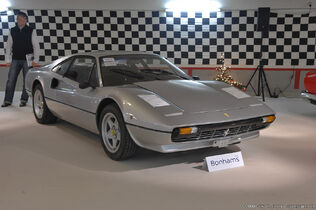
By 1971, all Ferraris had their engine behind the driver. It was during this year when the 365 GT4 BB, having a mid-ship boxer engine, replaced the Daytona. The 365 BB sold alongside the lesser 246 GT 'Dino' which competed with Porsche's 911 and was inappropriately called 'the poor man's Ferrari'. Throughout the seventies, major steps were taken to bridge the gap between the 246 and 365.
From 1968 to 1973, several evolutions of the 246 were released with about 3200 examples being made. During this time, pressure from products such as Lamborghini's Urraco and Maserati's Merak motivated Ferrari to release an entirely new 2 + 2. This car was the 308 GT4 as displayed at the 1973 Paris Auto Show. Like the 246, the 308 featured a transverse engine in the middle of the car, but differed greatly with its Bertone-styled body an all new V8, a very rare engine type for Ferrari at the time.
In 1975, Ferrari had Pininfarina restyle the 308 into what would become the real successor to the 246, the 308 GTB Vetroresina. This car featured sweeping curves, two seats and a resemblance to the 512B.
308 GTB Vetroresina[]
Highlighting the 308 GTB was a fiberglass, or vetroresina, body. Except for the aluminum hood, the entirety of the body was fiberglass which was manufactured by Carrozzeria Scaglietti, one of Ferrari's subsidiaries. Such construction marked the first time a composite body was sold on a production Ferrari.
The 308 GT4 provided a mechanical basis for the 308 GTB. A modified version of the oval-tube chassis from the 308 GT4 was used. The main difference between the two chassis was the engine mounting position, which was longitudinal on the 308 GTB.
For power, Ferrari used the existing tipo F106 engine with dry-sump lubrication on European models. If offered 255 bhp which piloted the 2425 lb (1100 kg) 308 GTB to 60 mph in just over six seconds.
With both the press and public, the 308 GTB was an instant success. After 700 examples, Ferrari made some cost-saving changes to their most popular product. These modifications included a steel body which saved many hours of time-consuming labor at Carrozzeria Scaglietti, but added 220 lbs (100 kgs).
The 308 GTB lived a long life with Ferrari. After several versions including the GTS, GTB4, GTBi, GTSi & Quattrovalvole, Ferrari updated the car to 328 specification in 1985. Later cars including the 360 Modena, 355 and 348 also continued the 308 GTB trend of having a rear-mounted V8 in a production Ferrari.
Bonham's Gstaad Sale[]
Bonhams' much-anticipated annual Sale of Fine Ferraris at Gstaad's charismatic Palace Hotel on December 19th will star the extraordinary Lepeltier Collection of 14 Ferraris - ranging from a 1961 250GT Short-Wheelbase Berlinetta, through the 1972 Geneva Salon 365GTB/4 Daytona to a pair of low mileage modern Ferrari classics, the 1984 288GTO and the 1989 F40 - the latter having covered barely 3,000kms in its life.
As offered for sale by Bonhams at Gstaad, the Lepeltier Collection today also features two Ferrari Dino models plus their successor, the early dry-sump engined 308GTB with bodywork in glassfibre (Vetroresina) - this striking car also wearing one of the rarest of all factory paint options, Verde Germoglio&peppermint green. After some 27 years in the Lepeltier Collection, this most attractive 'affordable Ferrari' has seen as little as 7,900kms use.